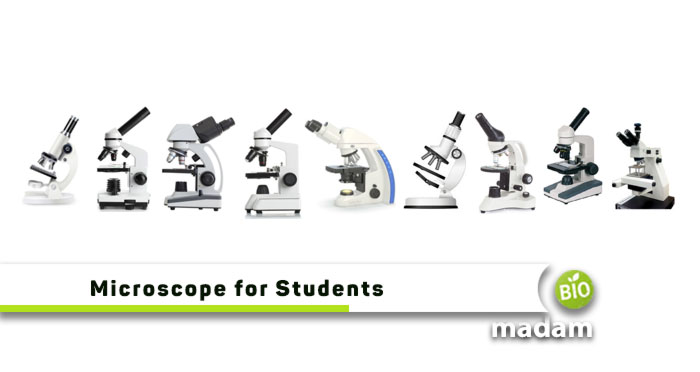Recently updated on March 7th, 2024 at 06:54 am
It’s been centuries now since the idea of a microscope first existed. Roman scientists used “burning glasses” in their scripts, but it wasn’t until the late 1300’s that the earliest microscope was made. Two ordinary Dutch lens makers, Z. Jansen, and his father gave the concept of a simple tube with two lenses placed at opposite ends. It ended up magnifying the tiny objects nine times more than the original one. Another scientist, August Kohler, later invented the uniform microscope illumination concept. It helped people take photographs of the specimen. Similarly, Ernst Leitz came up with different magnifications using multiple lenses on a movable gear at the lens tube end. And the process went on with more advancements until today when we’re using modern technology microscopes everywhere.
Let’s seep through a little more details of the microscope’s history and its use before considering its importance and checking different microscopes for student use.
Discovery of Cells by Robert Hooke
A scientist named Robert Hooke was the first in the midst-1600s to observe different things with a microscope. He is well-known for publishing an informative microscope book with the name Micrographia. He had his struggle collected in the book to attach numerous magnified objects seen with a microscope. One day he picked up a thin slice of cork and observed it. It was the time of cells discovery when R. Hooke examined tiny compartments and later named them “cells.”
Animalcules Discovery by Van Leeuwenhoek
Then came a Dutch scientist named Anton van Leeuwenhoek, who in the late 1600s worked to enhance the microscope’s magnification. He managed to enlarge tiny objects up to 270 times. He was the first one to introduce bacteria as he observed its components in his own teeth plaque. Moreover, he also examined yeast cells, microorganisms in pond water, and human sperm cells. After observing various minute objects under his microscope, he gave them the name “animalcules.”
Importance of Microscopes
The reason why a microscope is essential is quite apparent now. Different researchers, biologists, teachers, and scientists find it their immediate need to magnify numerous specimens daily. From simple microscopes to compound and electron microscope, each of them is inevitably important. We cannot even deny the importance of microscopes in the field of medicine and for students as well. We will see why a microscope is vital to students below.
Use of Binocular Microscopes in Schools
Over a few decades, the use of these ‘magic lenses’ has increased in schools. It is one of the best tools for making students excited about science. The most common microscopes employed in high schools are compound and binocular microscopes. So, we decided to add the top best microscopes for students, helping them learn and grow. A compound microscope with a concrete magnification is often sufficient for schools and colleges.
Essential to Biology Students
Biology is a part of natural science. It is essential that its teaching is through active learning and observing biological realities. Many things that are not visible to the naked eye are precious for students to experience first-hand and search through discovery learning. Just as we can’t deny the importance of learning about organisms, microorganisms, cellular structure, and organs, it’s vital to bring closer a microscope to achieve this purpose. Microscopy is a visual learning method; hence we can use it for practical work and demonstration methods.
Microscope Has Helped Science to Grow More
Science and its inventions are at another new level of success due to microscopes. Students can easily see right in front of their eyes what they study about cell structures and microorganisms’ existence. It is not difficult for them to science and its inventions are at another new level of success due to microscopes. Students can easily see right in front of their eyes what they study about cell structures and microorganisms’ existence. It is not difficult for them to see minor parts of animals, plants, and fungi.
Microscopes Help Other Fields Too
It is exciting that microscopy applies to many disciplines, beyond just science, from different branches of chemistry to forensics, earth science to physics.
How Has the Microscope Changed the World?
Natural science studies should involve active learning, investigation, and revelation of the world around us with critical thinking. Passive learning provides students with incomplete knowledge that is ineffective and unsatisfactory. Therefore, teachers need to use active learning and prepare curricular and extracurricular activities for students for faster and better adoption and innovative education.
Early science knowledge is essential for future scientists as well as for everyone else. Using microscopes in schools can:
- Provide practical learning.
- Promote seeing, doing, questioning, thinking, and discussing.
- Be used for other branches of science.
- Increase curiosity to look for new specimens
- Motivate some students to become a scientist
Microscopy helps in learning and memorizing facts and figures more easily than the traditional mode of teaching. One can say that the old, traditional way of teaching science neither evokes individual interest and enthusiasm in science nor produces the mental level to face and succeed in this modern, technology-dominated world.
How Can Students Improve Their Learning Process through Microscopes?
When students learn about operating microscopes, they relate this to many other aspects of knowledge and creativity. Microscopy teaches at two definite levels:
- Direct experience
- Indirect knowledge
Direct knowledge is all about microscopes, design, features, specimen preparation, etc. Indirect experience is provided when any image from any other educational subject is shown. Therefore, microscopy helps in learning about many issues.
What Can Microscopy do That Books and Videos Cannot?
Just looking is not enough. Students must learn to see, to brainstorm, to discuss, to ask, and to question. There are at least seven advantages of microscopy over textbook reading:
- It is a hands-on affair.
- Students are simultaneously using their eyes, hands, and brains.
- It is favorable for classroom discussions and question & answers sessions. Students can work individually and in groups.
- Students don’t learn facts; instead, they learn to use visual information, discover the unseen world, and operate it.
- Binoculars and telescopes can also be involved by extending the optics of a microscope.
- Students can learn about different specimens along with microscopes and optics.
- Microscopes are research tools as well as they are fun to use.
Education in science and technology is education with microscopes. Without microscopes, there are many achievements that the students won’t be able to achieve. So, let’s step towards grabbing the reviews of several microscopes by different brands.
Reviews on Best Microscopes for Students [Top Rated]
1 – AmScope M150C-I Biological Compound Microscope
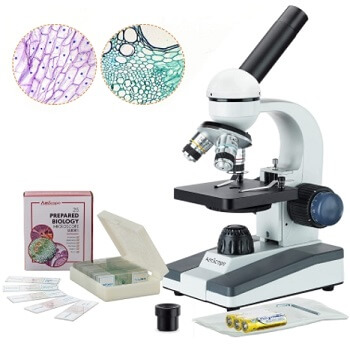
Prominent in AmScope M150C-I
- Expanded 40X to 1000X magnification with two eyepieces and three objective lenses.
- The biological compound microscope is excellent for students due to its portability.
- Consists of top-notch quality optics, is constructed with solid metal, and has a 360-degree rotatable head.
- Comes with a built-in LED illumination feature.
AmScope is among the leading brands offering the best student microscopes, particularly for biology students. This M150C-I is a specially designed cordless microscope with three objective lenses and two eyepieces attached for better magnification. Having a portable yet easy-to-access microscope is the top priority of all students, and this one fulfills the demand. The overall 40X to 1000X magnification makes it super convenient for beginners to observe different types of leaves, microorganisms, coins, blood cells, etc.
Not only does the LED microscope satisfies the needs of students, but it is also perfect to be used by homeschools, teachers, and biologists. All these people nowadays prefer AmScope M150C-I due to its great focus. Moreover, it has the coaxial focusing knobs attached on both sides of the microscope arms for easy specimen adjustment.
Students can spend hours examining different slides and still not get tired. The LED illumination system pre-installed in the microscope adds to its beauty. However, this microscope has limited use for university students. You can check for better options with enhanced light, binocular lenses, and extended magnification if you’re an undergraduate. All in all, this AmScope compound microscope is affordable and efficient to use for kids, students, and beginners.
| Why Go with This | Why avoid this |
|---|---|
| Best metallic material | Rough, sharp edges |
| Budget-friendly | Magnification above 400X needs improvements |
| Good angle of view | Not a good option for professional use |
| Multiple magnification settings | |
| Rotatable monocular head |
2 – Swift SS121 Compound Monocular Microscope
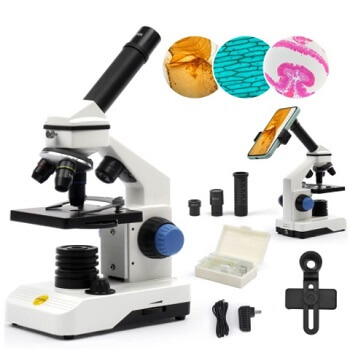
Prominent in Swift SS121
- The dual light feature helps examine both the solid objects and the translucent ones.
- The 360-degree rotatable head allows easy specimen adjustment.
- The microscope comes with a premium glass objective lens and an additional 2X lens to magnify objects up to 2000X.
- The pre-equipped ABS case promotes the portability of microscopes for students.
- It has fine focusing knobs along with spring-loaded stage clips.
The SS121 by Swift is another top pick for students, especially beginners. The Swift Biological Microscope Kit is the perfect tool for students of all age groups. Now you can easily place this lightweight monocular microscope in your laboratories and let the students focus on microscopic objects through the 45-degree inclined ocular tube. In addition, it has an all-rounder rotatable head to allow the students to observe different specimens comfortably.
One fantastic feature that the company added is its extensive magnification range, from 80X to 2000X! This wide focusing range offers a crisp and clear image of whatever specimen you observe. It can be as small as a cell to even some solid objects.
Another prominent feature is the microscope’s metal body, ensuring long-term object use. Even if you are a beginner, you can still conveniently adjust the slide through spring-loaded stage clips. What amazes the customers is its ability to work with a power adapter as well as batteries. Not just this, but the kit arrives with an additional bulb for replacement in emergencies. The coarse and fine focusing characteristics guarantee the students focus entirely on the adjusted specimen. Despite this microscope being an ideal product for beginners and students, its objective lens with 4X magnification needs improvements. In addition, this particular lens sometimes displays blurry vision. But, all in all, this Swift SS121 Microscope is the best for under 100 dollars.
| Why go with this | Why avoid this |
|---|---|
| Sturdy metal base and body | The top illumination system doesn’t cover the 40X objective lens |
| Comes with a 2X additional lens | |
| Dual LED illumination system | |
| Convenient to use | |
| Affordable |
3 – Celestron LCD Digital Microscope II with Digital Camera
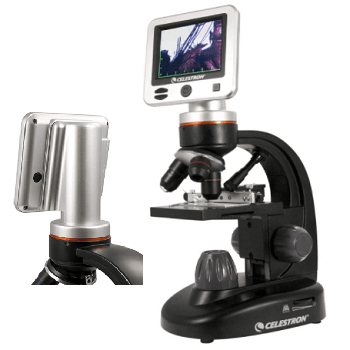
Prominent in Celestron Digital Microscope
- The adjustable microscope has a built-in 5 MP digital camera to capture productive and enchanting images.
- Now you can capture and save high-resolution images up to 600 with the pre-included 1GB micro SD card.
- The magnification extends from 40X to 1600X with digital zoom, ideal for observing cellular objects.
- The dual-axis, fully adjustable mechanical stage helps convenient and accurate positioning of specimen.
- The packaging includes a dust cover, a rugged canvas carrying case, an AV out cable, five prepared slides, and an AC adapter.
The LCD Digital Microscope II is an advanced technology by Celestron that is perfect to be used by students and younger kids. As the name indicates, this microscope features an LCD screen, making STEM education easy for students. One fantastic feature is its ability to record images and videos through the embedded 1 GB micro SD card. Now your kids and students can save up to six hundred images in the microscope and observe them later to understand the organism’s specs. It has another benefit too! Students of primary and secondary sections can save the pictures to further present them as a project before their teachers.
In addition, the camera zooming quality through different objective lenses, 4X, 10X, and 40X, is fantastic! A unique sensor acts as a 10X lens and magnifies these above lenses to 40X, 100X, and 400X, respectively. Isn’t it great to observe even the smallest of objects like bacteria, yeasts, blood, molds, fungi etc. Besides, the microscope also helps enlarge solid objects, such as coins, stamps, leaves, etc. A few limitations are seen as well, but those can be neglected as overall, it’s a decent microscope. Unfortunately, you can only see a flat specimen with the 40X magnification as it has some focus adjusting issues. Other than that, we wish the LED illumination system were a little brighter!
| Why go with this | Why avoid this |
|---|---|
| Great LCD | LCD may not work at low battery |
| Sleek design | The top LED light intensity needs improvements |
| Effective 5 MP camera | |
| 30 fps video recording | |
| Easily magnifies microorganisms (e.g., parasites) |
4 – OMAX LED Binocular Compound Microscope
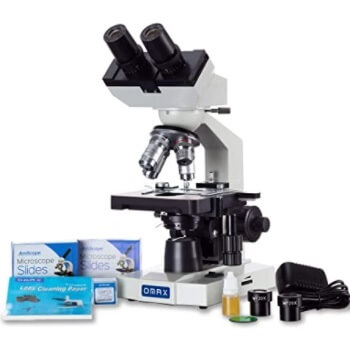
Prominent in OMAX Binocular Microscope
- This biological microscope has eight outclass magnification levels ranging between 40X to 2000X.
- The microscope has an already installed LED illumination with customized intensity levels.
- The mechanical stage is double layered with easy movement in X, Y, and Z positions for the centering or scanning slides.
- The coarse and fine focusing knobs promote the comfy adjustment of prepared slides.
The OMAX binocular microscope is one of the best technologies for students and researchers, offering excellent features for just under $200. The intuitive design is the critical factor to attract most students, so they can prepare slides of microorganisms and observe them under the microscope. It has a sturdy metal construction with top-notch quality objective lens for better results. OMAX offers almost all features in an affordable range compared to other expensive microscopes. This binocular compound microscope follows a magnification between 40X and 2000X, so learners can use the lens per their specimen’s need.
The brand became a center of attraction for high school and college students, researchers, and biologists. One can easily magnify smaller objects by adjusting through the coarse and fine adjustments, for example, yeast cells, bacteria, protozoa, and other such parasites. In addition, the LED illuminating lights help the observer examine different specimens in bright light. This flexible and convenient-to-use microscope comes with 100 prepared slides and cleaning paper. Overall, OMAX is an ideal option to buy when looking for economical yet best microscopes for students, but note that it lacks a user manual. Another con seen is the rugged construction of focusing knobs, but this can be neglected when you get an excellent package with tremendous benefits at a low price.
| Why go with this | Why avoid this |
|---|---|
| Sturdy metal construction | The adjustments knobs are roughly constructed |
| Comes with a binocular head | Doesn’t include the user manual |
| Easy to install | |
| Excellent image quality | |
| Best optics to observe protozoa, bacteria, etc. |
5 – YINAMA LCD Digital Microscope for Students
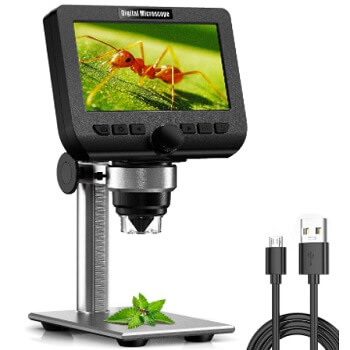
Prominent in YINAMA LCD Microscope
- This LCD microscope has two magnifications; 50X and 1000X.
- The YINAMA student microscope comes with a 2 MP camera, allowing you to examine the tiniest specimen details clearly.
- Now you can save the captured images and videos on the already present 32GB micro SD card and observe them further on the 4.3-inch LCD screen.
- The digital microscope can be connected to PCs and wireless systems and is compatible with iOS and Android devices.
- It has eight adjustable LED lights to provide the best illumination system while studying objects.
The digital LCD microscope by YINAMA is another option to choose when looking for the best microscope for students. The company especially prepared a 4.3 inches LCD screen to observe the magnified specimen on the screen easily. Customers are happy with its compatibility feature as you can connect the technology with either PC or wireless devices. It doesn’t matter if you’re an iPhone user or an android; this digital microscope will connect to both! Besides, it has an impressive and rechargeable battery that can continuously work for up to four hours. Students find it easy to work on this microscope due to its lightweight and portability.
Although the YINAMA microscope is an excellent pick for students, it still has some drawbacks. First of all, the microscope is limited to only two magnification levels; 50X and 1000X. Therefore, you can either magnify the object fifty times or a thousand times, and there is no in-between! Further, most teachers do not recommend it for medical purposes as the microscope cannot enlarge cellular objects. Therefore, it is only confined to seeing coins, stamps, leaves, gems, jewelry, etc. Other than that, if we talk about the image/video quality, that is great! You can watch the magnified objects at 720p as well as 1080p resolution. Moreover, the eight LED lights pre-installed help the users comfortably adjust the specimen and observe it. In the end, it depends on the customer’s needs and preferences, so you can obviously go for buying this microscope with 32GB of microSD storage.
| Why go with this | Why avoid this |
|---|---|
| Comes with a built-in rechargeable battery | Cannot magnify cellular organisms |
| Best for students, scientists, and hobbyists | The 1000X magnifying lens needs improvements |
| Suitable to examine gems, coins, insects, etc. | |
| Clear LCD | |
| Budget-friendly |
Buyer’s Guide – What to Look for in a Student Microscope
There are a lot of factors to consider when buying a new microscope for students. Different types of microscopes serve various purposes, but when we mainly talk about students, the following points should be kept in mind:
Magnification – Monocular vs. Binocular
One should always analyze the type of objects he has to observe often. Monocular microscopes come with a single lens that usually magnifies the specimen up to 1000X, and most students find it easy to use. Other than that, binocular microscopes contain two lenses that, of course, have an expensive price tag.
Portability
It is one of the most important factors to consider by students before buying a new microscope. Students have to complete their tasks and roam around the institute to discuss study matters, so it is crucial to have a portable microscope. Nowadays, most LED microscopes are very lightweight and highly portable.
LED Illumination
We recommend you purchase a microscope with LED illumination as this feature helps you quickly adjust and focus on the specimen. The technology has advanced a lot, and now you can even find LED microscopes at lower prices. Students can check for the light system installed in the desired microscope and then buy it.
Objective Lens and Eyepiece
The objective lenses and eyepieces are two critical parts of every microscope, and these should always be considered. More lenses mean you have got an extensive range of magnification to enlarge the desired specimen, which is what a student demands. For example, buying a microscope with 40x, 100x, and 400x magnification means it has three objective lenses, so a beginner/student can easily watch an object as small as a microorganism (bacteria, yeasts, etc.)
Price
Getting a microscope at an affordable price yet having all its features is what everyone looks for! Obviously, we know it gets difficult for students to buy expensive microscopes, so always look for budget-friendly options and fulfill the magnifying needs. The article above has added a complete list of cheap and flexible microscopes for students.
Frequently Asked Questions – FAQs
Which type of microscope do most students use?
Nowadays, most students prefer using a compound light microscope that helps identify and enlarge even the most minor details of a specimen. As a result, almost all the institutes and science labs contain these microscopes.
Which microscope is best for high school students?
It depends on the magnification of a microscope and a student’s need. Most high school students are recommended to use microscopes having a magnification range between 400X and 1000X. This extensive range can help magnify specimens like blood cells, bacteria, viruses, etc.
Which microscope is suitable to view viruses?
Viruses are microorganisms that can only be seen through Electron Microscopy. The market is full of EM, but these have a bit expensive price tag due to being highly efficient.
Can a student observe bacteria with a 40X lens?
No, a 40X lens isn’t enough to observe bacteria details. However, a typical bacteria can be examined when adjusting a 400X magnification lens in a compound microscope at most minuscule. This range helps a user detect sizes as small as 450 microns.
Our Recommendations
Although all of the microscope products mentioned above excel in their functions, we’d recommend you get your hands on Celestron LCD Digital Microscope II with Digital Camera if you’re a primary-level student. This one is perfect for magnifying objects like jewelry, stamps, coins, etc. Similarly, OMAX LED Binocular Compound Microscope is the best for higher secondary level or college students!

Anna has completed her degree in Pharmacy from the University of Hawaii. She is serving as a research assistant in a pharmaceutical company. She had a great interest in writing blogs, traveling to different parts of the US, and trying delicious recipes in her spare time.

